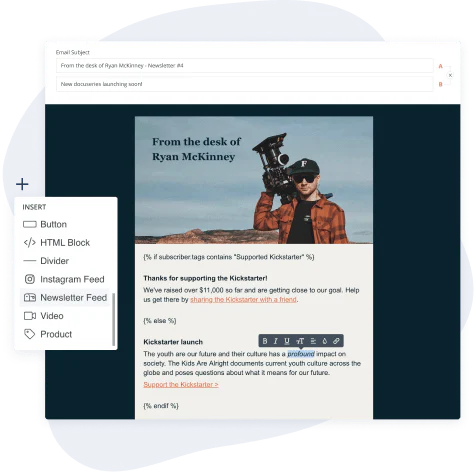In this Article
As scary as it can be to start a newsletter, sometimes it’s even more challenging to come up with a name for it that feels just right.
Fortunately, you don’t need to reinvent the wheel to brainstorm great newsletter names.
We’ve found a few tried and true formulas to help you crack the code for generating newsletter name ideas. You’ll also see some great examples of catchy newsletter titles to get your wheels turning.
Why your newsletter needs an out-of-the-box name
If you’ve ever struggled to come up with a newsletter name that you click with, you probably asked yourself, “Do I really need to name this?” at least once.
The truth is that you do! Your newsletter name is part of your brand, which means it’s a small but essential detail to engage with your audience. Some creators simply name their newsletters after their blog or brand, while others create a separate, complementary identity.
Whichever route you take, picking a name for your newsletter will help you:
Build and strengthen brand awareness
A consistent and memorable name helps keep you—and your brand—top of your readers’ minds. A unique name is also easier to refer to since it stands out in your mind. Finally, a newsletter name that stands out in the inbox can boost open rates and engagement.
Look official and cultivate trust
Your brand is never too small to treat with care and respect. Consistent naming and branding help you present as the leader you are. Nearly 70% of consumers state that a clear mission and values on a company’s website or socials build trust, and the name you choose can go a long way in establishing positioning.
Anne-Laure Le Cunff, whose Maker Mind newsletter reaches over 20,000 subscribers every week, shares:
With a separate name, the Maker Mind newsletter became a mini-publication, related yet independent of the core business. Having a separate name gave me the flexibility to create other newsletters in the future with different content and target audiences. For instance, I currently have another newsletter just for paid members called The Ness Letter.
– Anne-Laure Le Cunff, founder of Maker Mind
Curate an exclusive experience
Personalized content is key to growing your newsletter, and a creative name designates a space for your best content. You can use this exclusivity to your advantage on your newsletter’s landing page, just like Teela Cunningham does with her weekly newsletter, the Tuesday Tribe. As part of the tribe, the people in her newsletter are the “first to nab special deals.”
Crafting the perfect name for your newsletter (+ inspirational examples)
So, how do you come up with a newsletter name? Our method has two parts to help you come up with a name: an associated word brainstorm and plugging your terms into creative naming formulas.
Brainstorm words related to your content
The words you choose have a significant impact on what potential readers assume about your brand. You need fuel to make newsletter formulas work, and at this stage, there are no bad ideas.
Start making a list of words that include your name, niche, and unique perspective. Sometimes, looking through lists of adjectives, phrases, and adverbs can help. Don’t worry about editing just yet. Even if you don’t love a term, write it down because it may inspire a different idea.
If the flywheels aren’t turning, think about who your target audience is, how you want them to feel, and how you want to help them.
We’ve come up with a few theoretical newsletter names for different audiences in the same niche to illustrate this. As you review them, think about who each would target and what their perspective might be:
- Bashful Baker vs. Baking Without Borders
- Parents Who Podcast vs. The Podcast Professor
- Glamorous Gallivant vs. Have Budget, Will Travel
Once you have the raw ideas, it’s time to move to the next step.
Run your words through these 9 newsletter name formulas
If your brainstorm list looks messy, don’t fret. To help you, we compiled a long list of our favorite newsletter names and asked, “What do these have in common?” The result is nine formulas to try on for size.
Formula #1: The [adjective] [noun]
The first formula is the simplest. All you need to do is take an adjective of choice and attach it to who you are or what you do.
These are our top newsletter name examples:
- The Thrifty Homesteader by Deborah Niemann
- Budget Bytes by Beth Moncel
- The Clean Eating Couple by Liz and Tyler
- Dense Discovery by Kai Brach
- The Literary Lifestyle by Jules Buono
- Unmistakable Creative by Srini Rao

Thinking about how you want to help readers may inspire your newsletter name. For example, Dense Discovery aims to help people feel inspired and think critically. Image via Dense Discovery.
Formula #2: Puns and play-on-words
Life is fun when you use more puns. A clever play-on-words will catch your reader’s attention and stand out in their mind.
Examples of this type of newsletter name are:
- The Butter Half by Abbey Rodriguez
- The Mad Fientist
- Extra Paint by Eric Friedensohn
- A Dose of Vitamin Ray by Dr. Ray
Formula #3: Your perspective
No matter how saturated you think your niche is, there’s nobody exactly like you. Having a unique perspective or alternative opinion helps your target audience think, “Hey, that sounds like me!”
Perspective-based newsletter names include:
- Sleeping Should Be Easy by Nina Garcia
- Fewer Better Things by Per Håkansson
- Noticing by Jason Kottke
- Create & Sell by Brennan Dunn
- Daily Stoic by Ryan Holiday
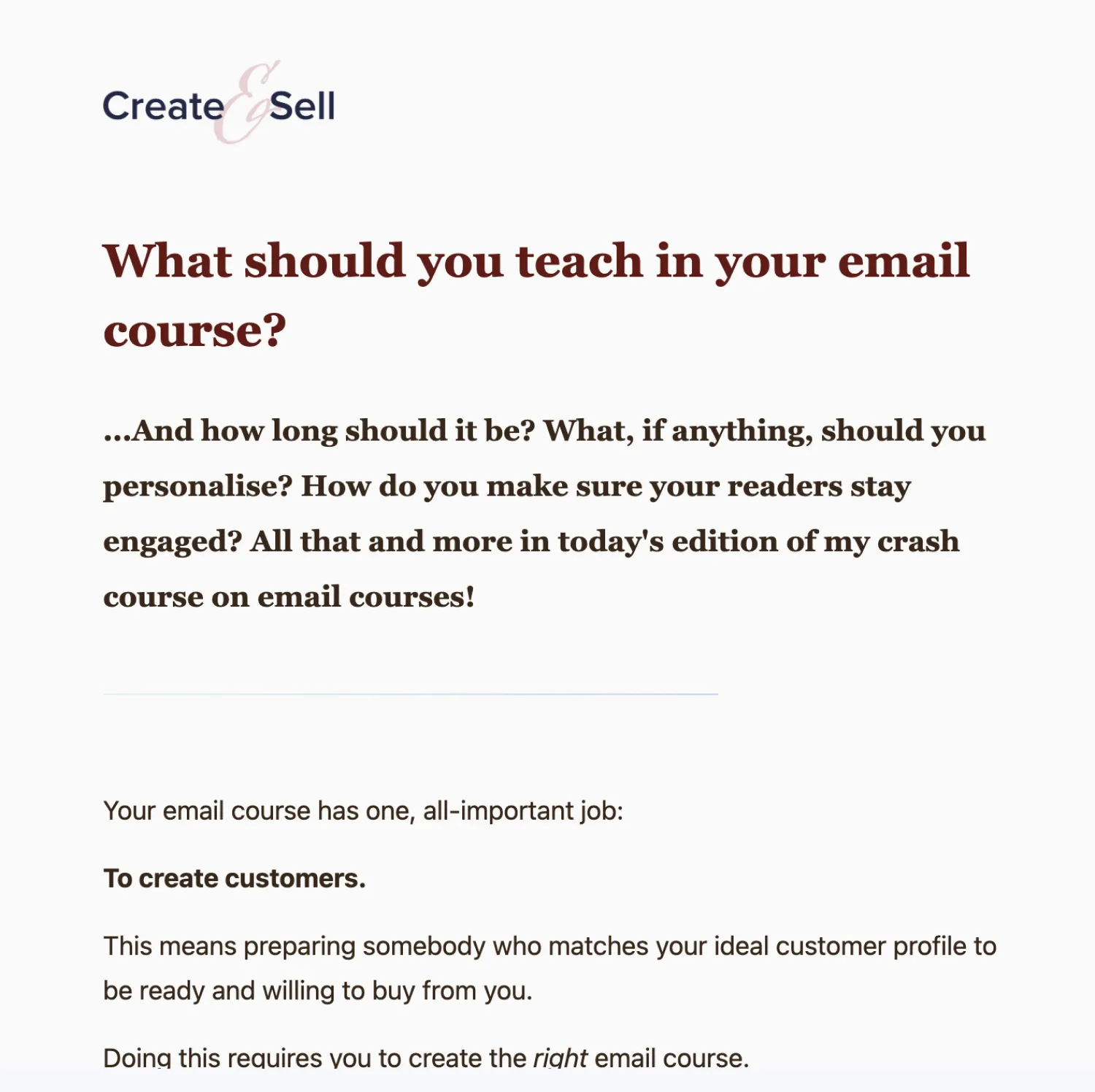
Brennan Dunn brings his perspectives on email marketing to the table with his Create & Sell newsletter.
Formula #4: Phrases with a twist
If you like longer newsletter names, look to these “phrase with a twist” examples. Taking a phrase and swapping a word or two can encapsulate a big idea in a small sentence.
Wrap your head around these twisted examples:
- My Forking Life by Tanya Harris
- The Blog Abroad by Gloria Atanmo
- Modern Mrs Darcy by Anne Bogel
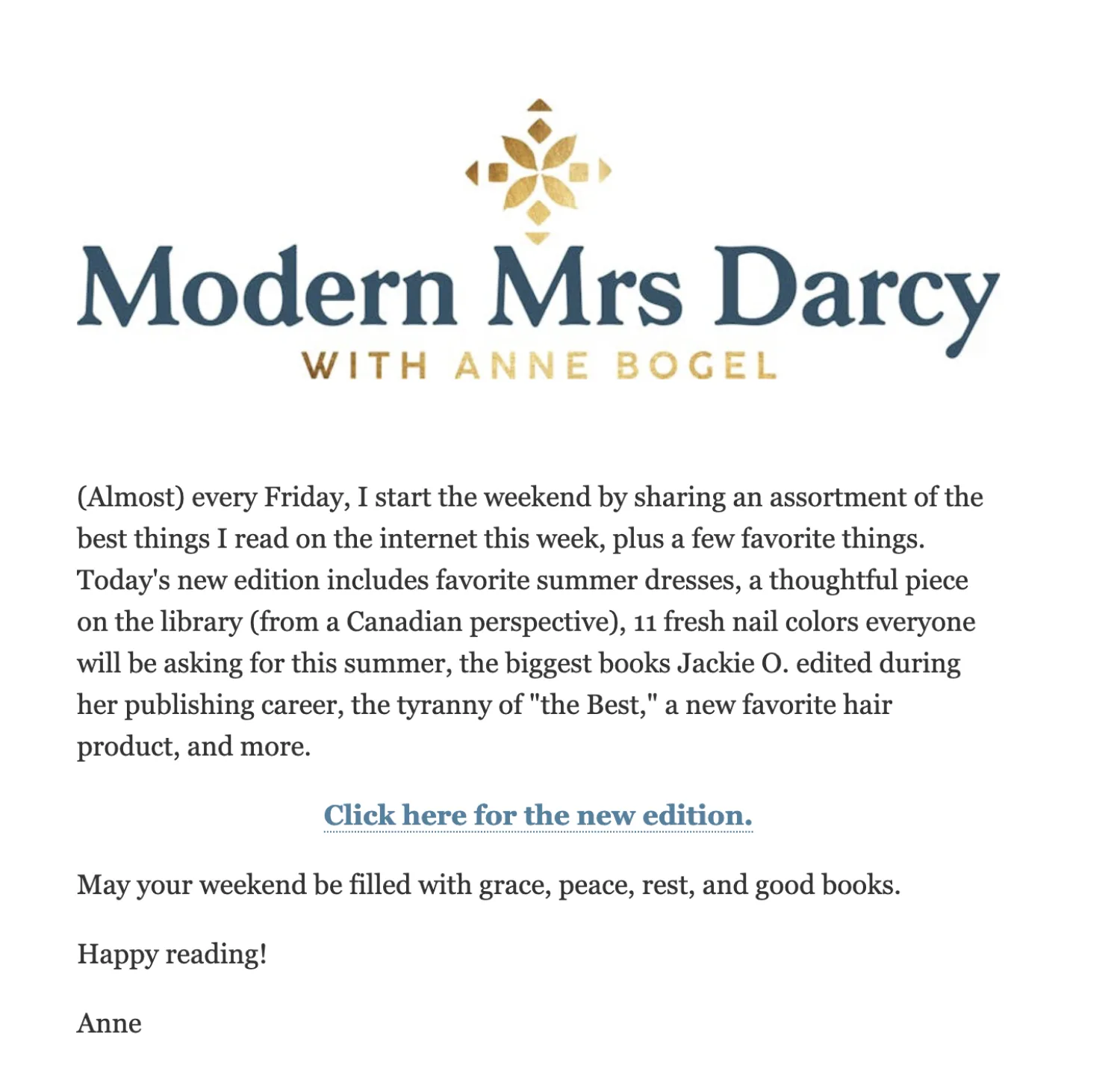
Anne Bogel’s Modern Mrs. Darcy is a nice ode to the Jane Austen book Pride and Prejudice.
Formula #5: Your name
You don’t need to be someone you’re not in your business. Being yourself makes you more authentic.
We’ve noticed plenty of newsletters are named after the creator or inspired by their name. Establishing it under your name is a good option if you haven’t chosen a topic yet.
Some creators that use this newsletter naming method include:
- Nick Talks Money by Nick Meyer
- Enneagram with Abbey by Abbey Howe
- Christian Howes Newsletter
- Xayli Barclay
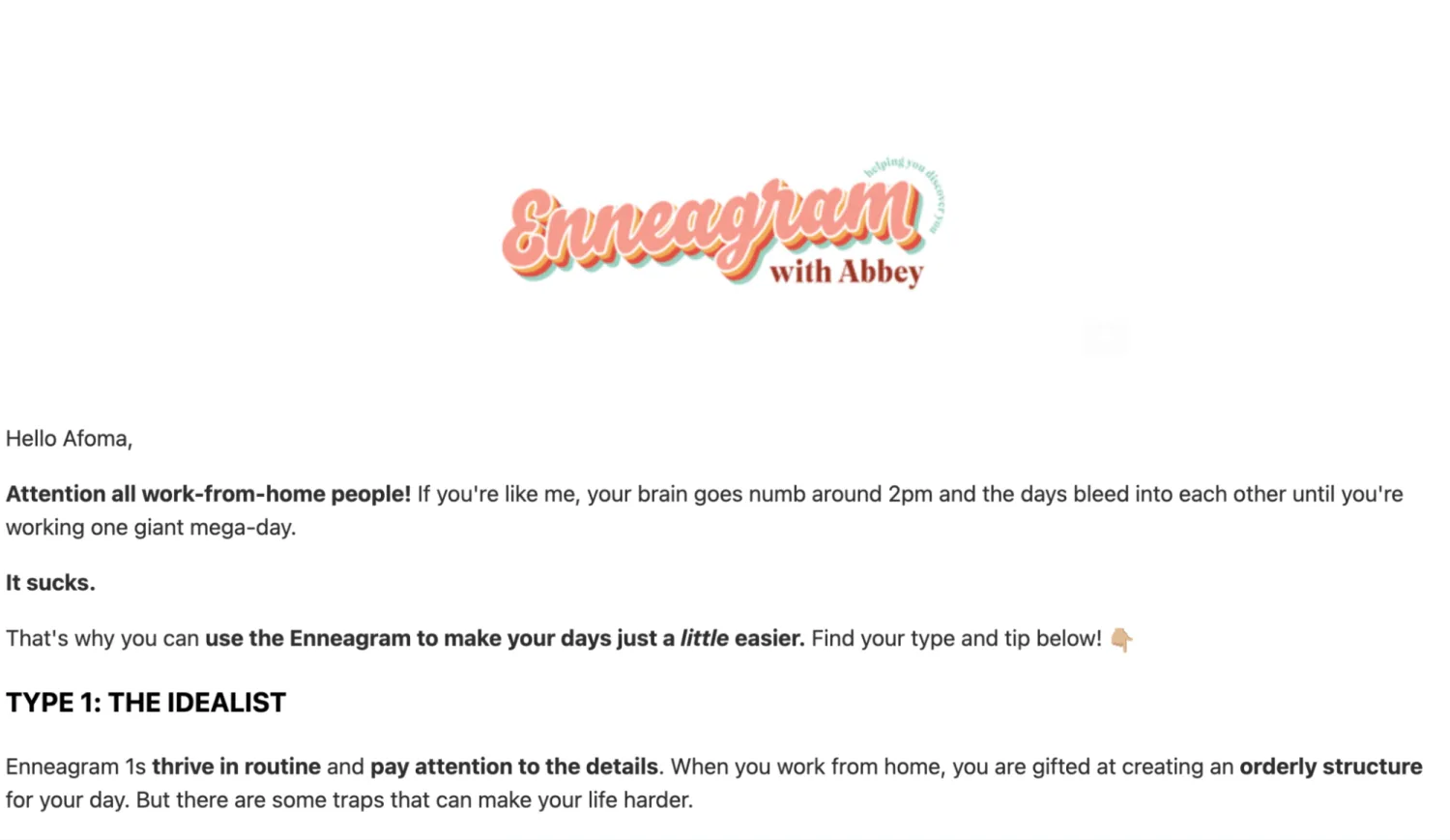
Abbey Howe mixes her name with her interest in the Enneagram
Formula #6: Your blog’s name (or a subsidiary of it)
If you’re creating a newsletter after establishing a blog or brand, you might carry the theme to the inbox. You can either go by “The [Company Name] Newsletter,” or a subsidiary phrase.
Here are some newsletter blog name examples:
- Kit Newsletter, by (you guessed it!) Kit
- Reading Middle Grade by Afoma Umesi
- The Book Devotions by Michelle Watson
- Mighty Freelancer by Rachel Pilcher
- Freelance Bold by Marijiana Kay
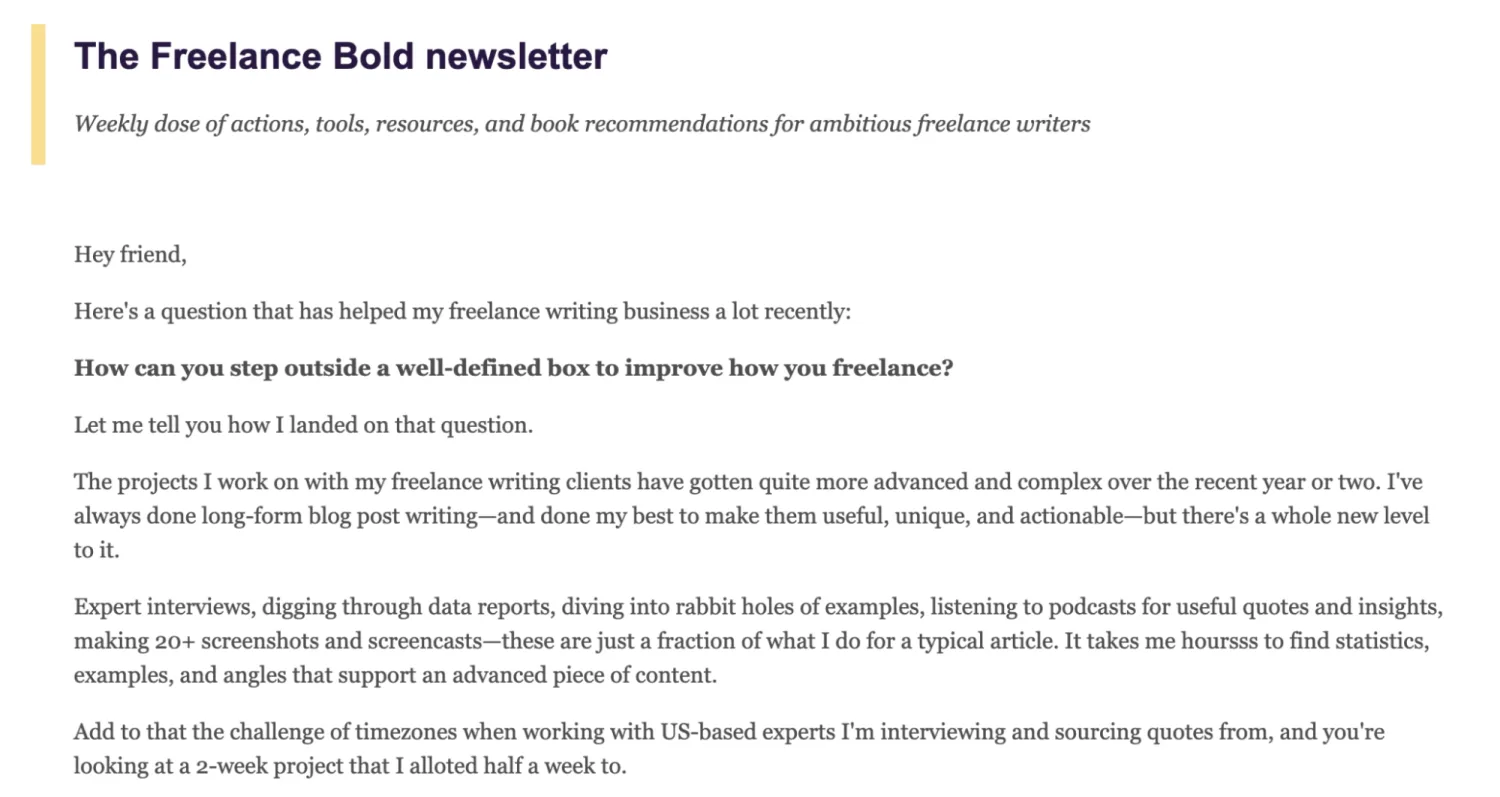
The Freelance Bold newsletter bears the same name as its root blog
Formula #7: Alliteration
Simple phrases with the same leading letters that roll off the tongue. Using alliteration helps your newsletter name become memorable.
Newsletter name examples that use alliteration:
- The Tasty Travelers by Lauren Cardona
- RadReads by Khe Hy
- Wait But Why by Tim Urban
- Maker Mind by Anne-Laure Le Cunff
- Creative Caffeine by David Sherry
- Maker Mail by Sarah Stearns
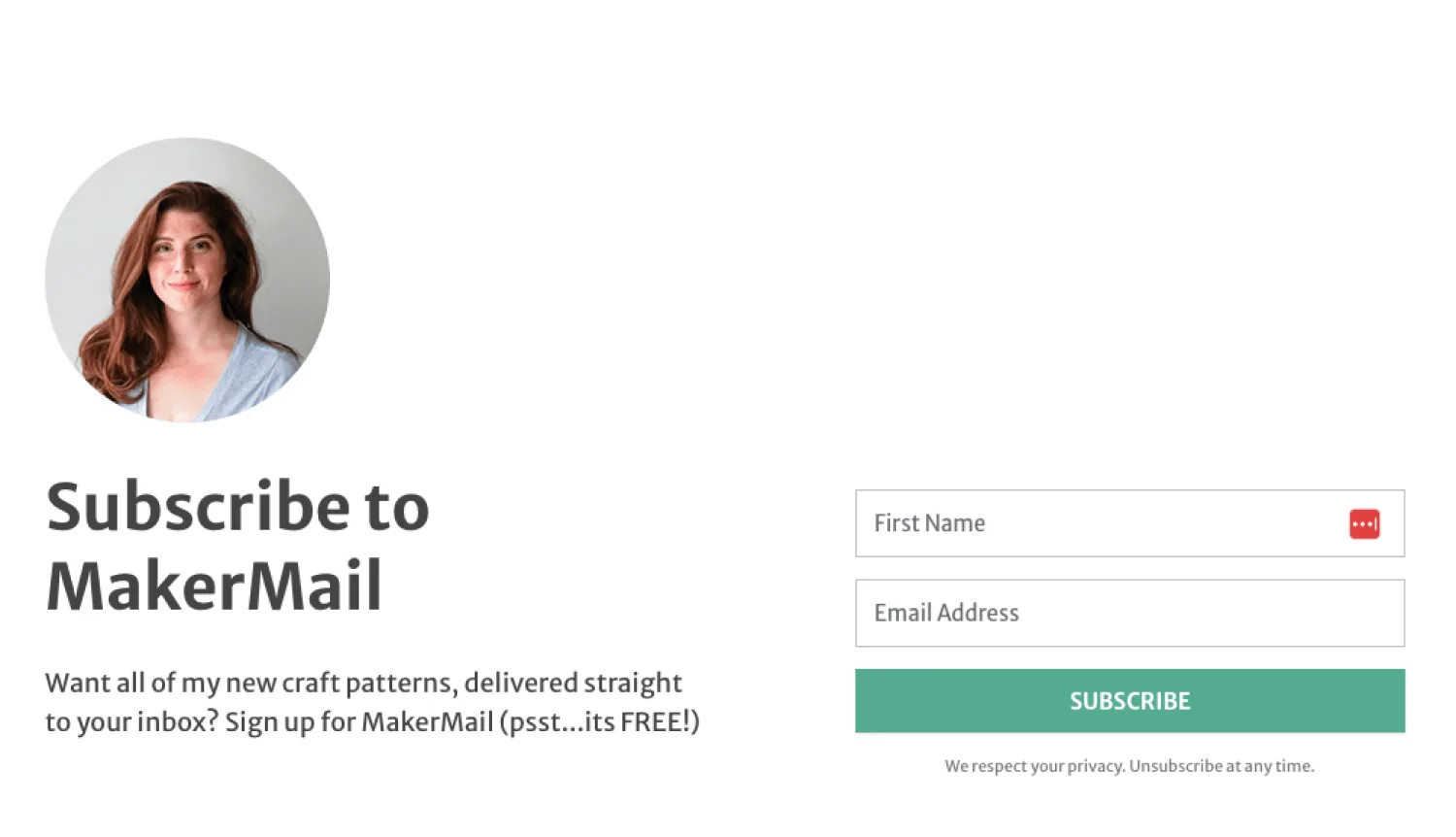
Maker Mail captures Sarah Stearns’s creative interests
Formula #8: Time-based
Consistency is critical for a successful newsletter—putting the send day or frequency in the name sets expectations early. The only thing to keep in mind if you’re thinking of using this naming formula: choose a time you can commit to. Here are our favorite time-based names:
Examples of time-based newsletter names:
- 3-2-1 Thursday by James Clear
- Slow Brew Sunday by Jules Acree
- The Tuesday Tribe by Teela Cuningham
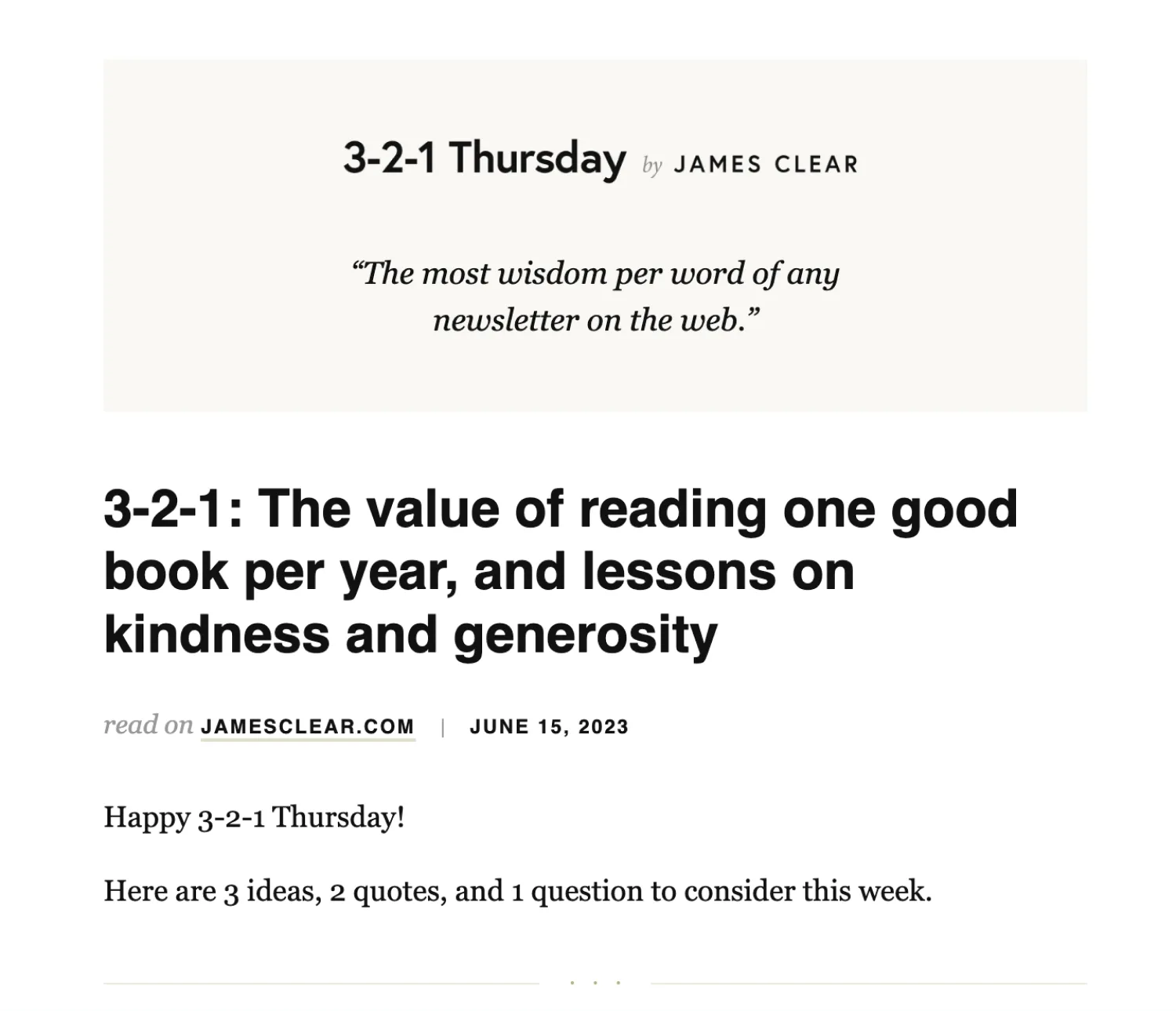
James Clear’s Thursday newsletter stays true to its time-based name
Formula #9: Rhyming
Another fun way to play with words while naming your newsletter is to try rhyming. This involves using words with similar-sounding endings. You can create a subtle, gentle rhyme or go all out with an unmissable rhyme.
Newsletter title examples that use this tactic:
- Content Connect by Ashley Cummings
- Home-Cooked Roots by Nicolette Wax
- Cucina by Elena by Elena Davis
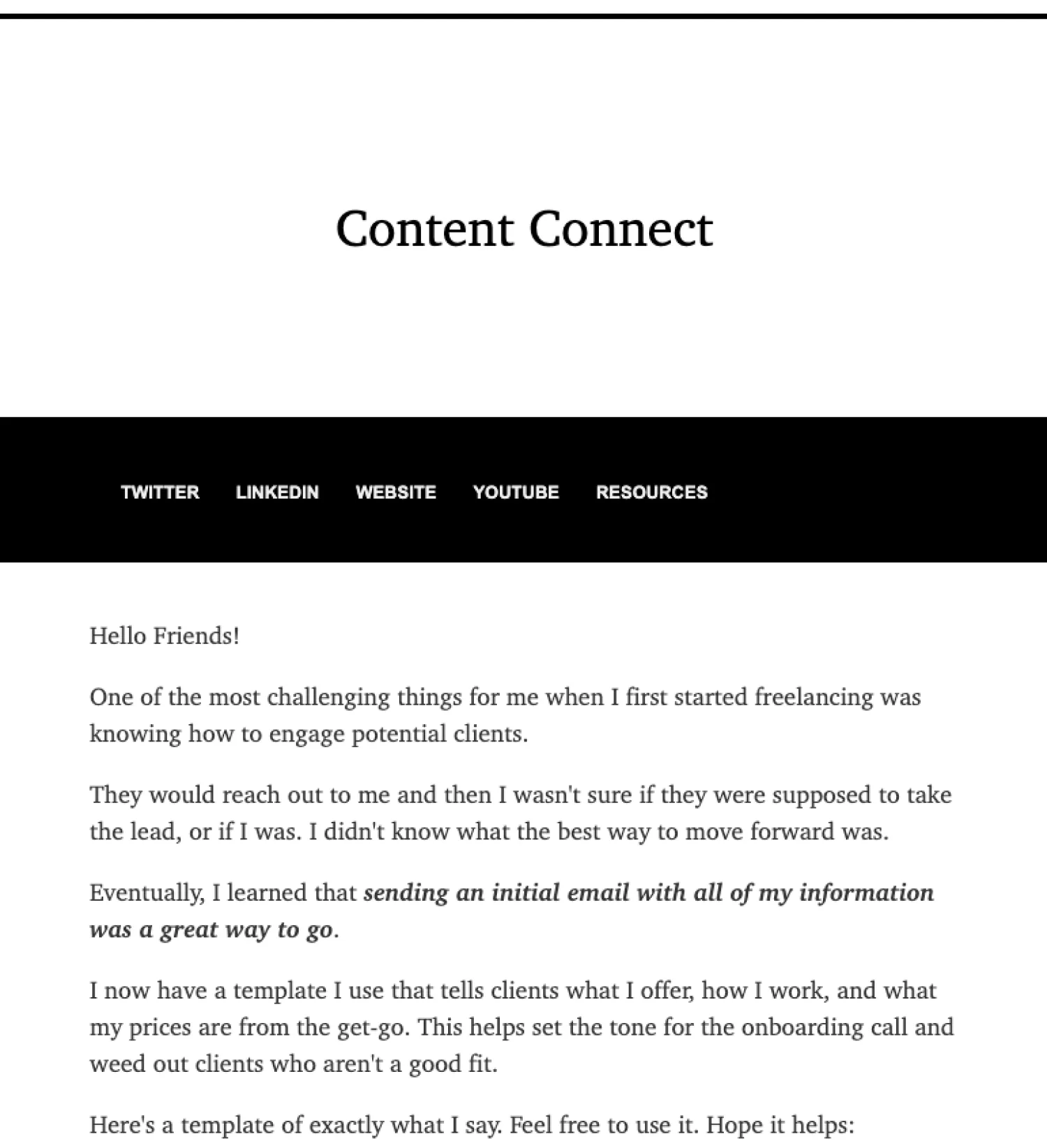
Ashley Cummings’s Content Connect has a nice ring to it
The 5 locations to feature your newsletter name
After you’ve chosen a name, it’s time to shout it from the rooftops! Or, more realistically (and probably safer), your landing pages and signup forms.
Here are five essential spots you should share your new-found identity:
1. Your newsletter landing page
Think of your newsletter landing page as the front gate into your magical kingdom of content. This is the spot where you’ll let potential subscribers know what to expect from your emails and give them a place to sign up.
The example from Eric Friedensohn’s newsletter Extra Paint below tells you how often you’ll receive it and the type of content to expect.
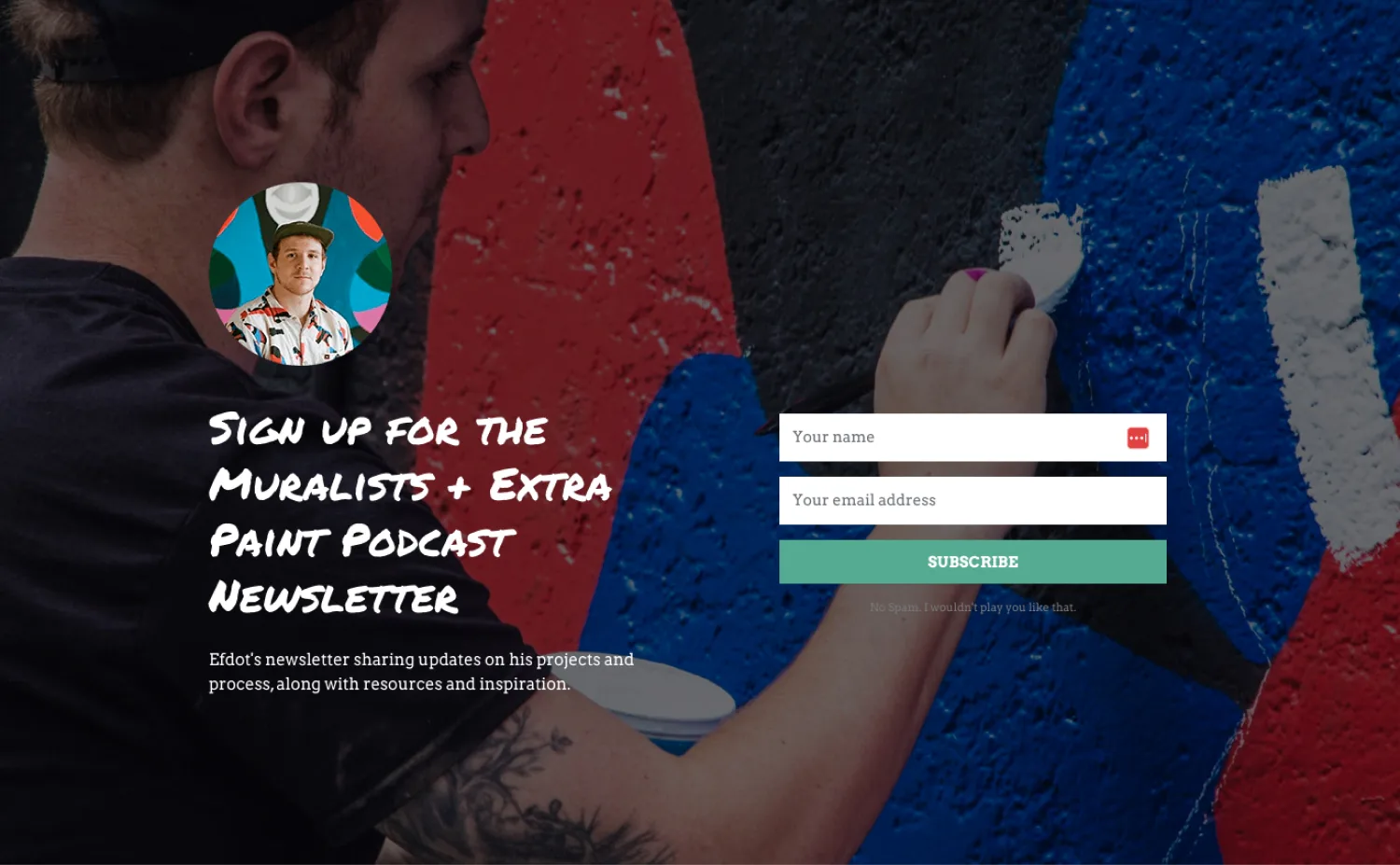
2. Your newsletter signup form
Another spot to include your newsletter name is on the sign-up form. These smaller blocks won’t have as much information as a full landing page, but you’ll have plenty of room to present your value proposition.
Kit’s form builder lets you choose a form that’s inline with your page, pops up on your site, or slides in as someone browses your blog. Jules Acree’s newsletter signup is inline with the content on the home page.
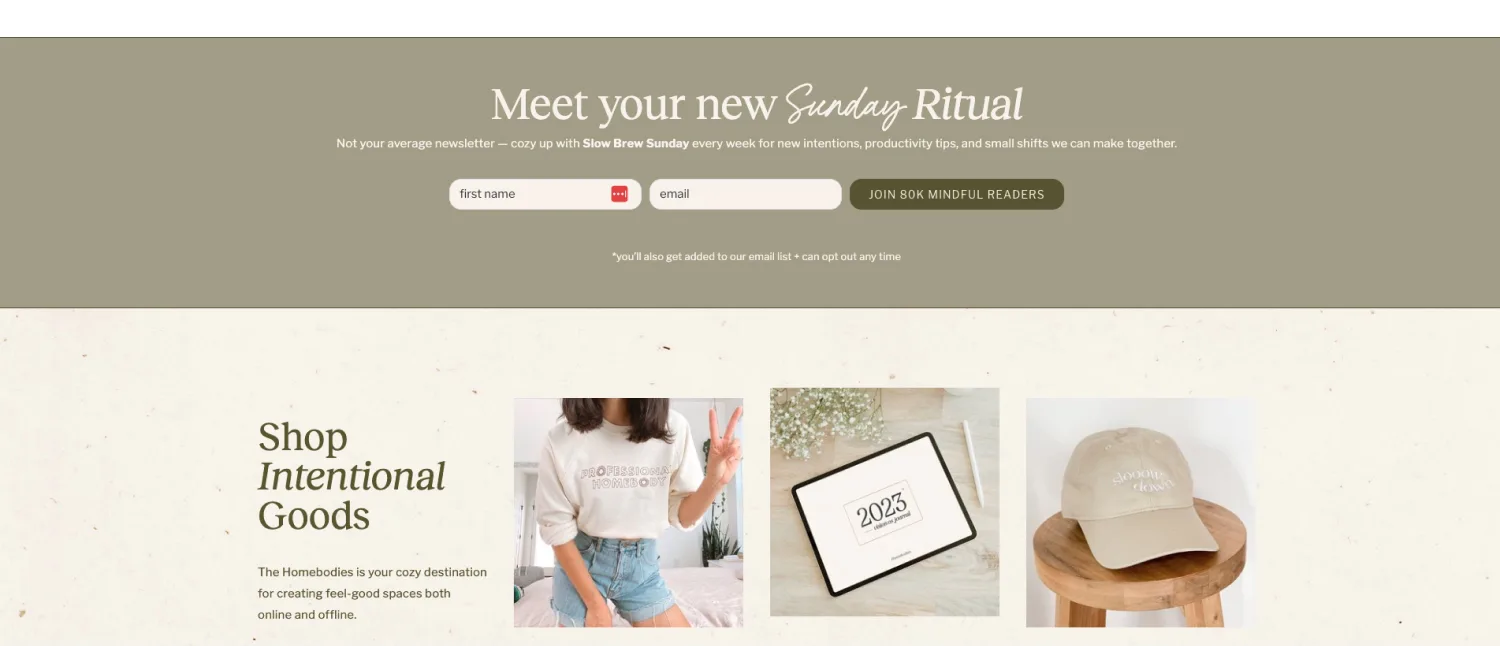
Newsletter sign up forms fit on any page in your website and give people a place to sign up for your emails.
3. Your sender name and newsletter subject line
Once someone signs up for your newsletter, you need to carry your branding into the inbox. The first place to include your name is in the subject line or as part of your sender name.
For example, I include both my name and business name in the “from” section. Sending my emails from “Afoma @ Reading Middle Grade” puts me front and center as the creator while also giving context about my brand.
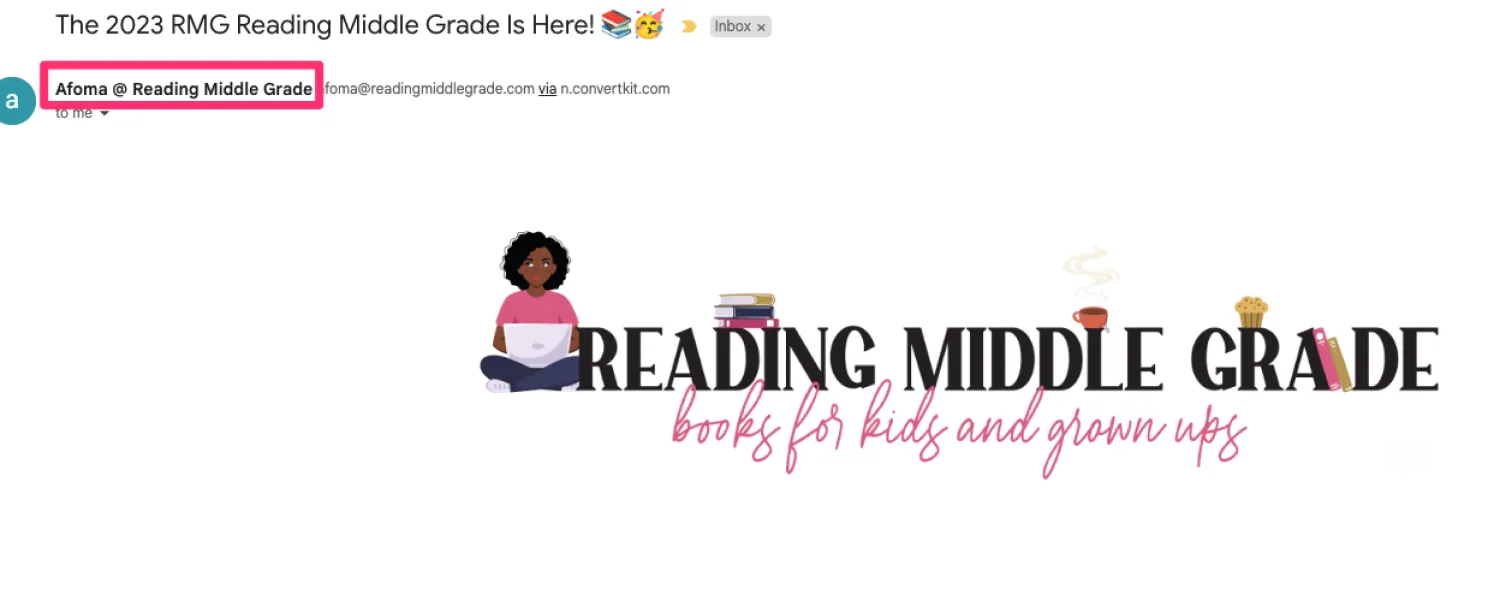
4. At the top of your newsletter email
Once a subscriber gets into an email, you can include your branding at the top of the message in a header image.
In the example from Jay Clouse’s Creator Science below, the message starts with the blog’s logo. Adding a header image is a simple way to add personality to your newsletter design. Just make sure to add alt text to preserve deliverability.
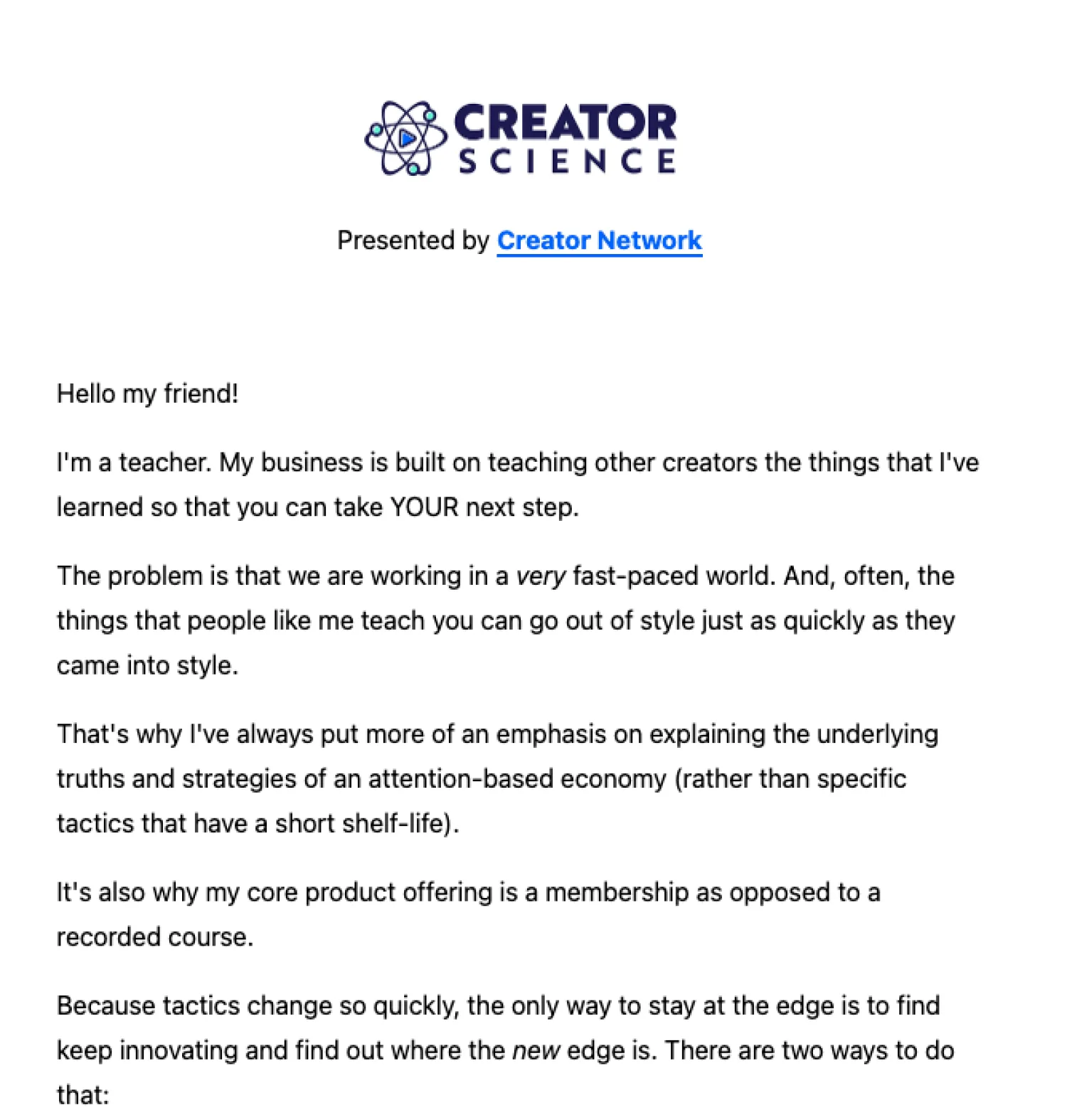
We’re firm believers that text-based are the way to go, but that doesn’t mean your newsletter has to be plain. A simple logo at the top goes a long way for brand recognition.
5. In your newsletter’s footer
If you want to make your emails feel more personal and connect your face to the brand, consider a stylized footer. Janssen of Everyday Reading uses a well-designed footer to showcase her newsletter and brand name.
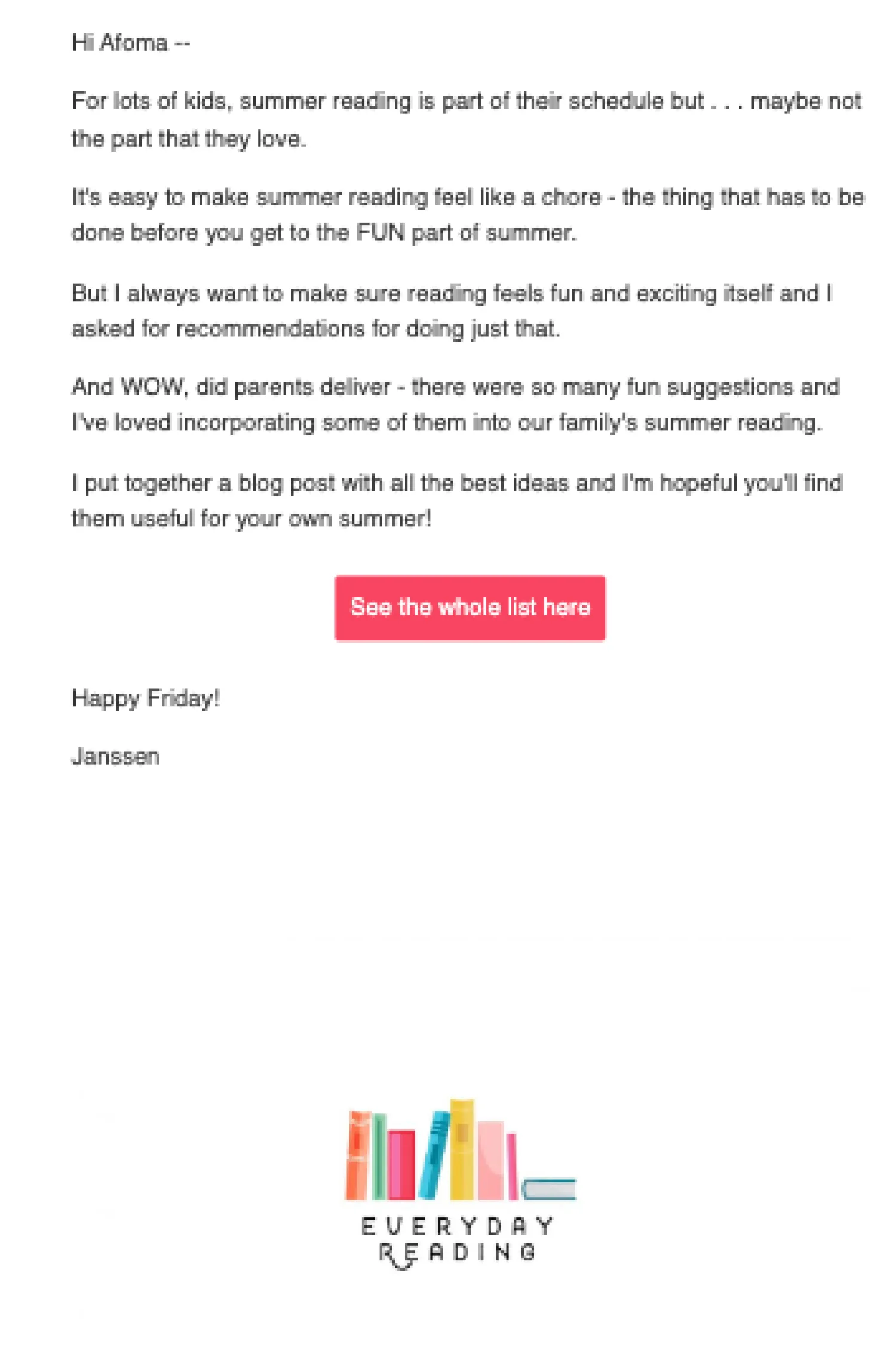
A newsletter footer is a stylish way to highlight your newsletter name in your emails
The footer is also a great place to build anticipation about what’s to come or link to useful pages like your best content or paid resources.
Ready to start something new? Kit can help
A great newsletter name is important – but it also needs to deliver compelling content over time. Once you’ve got your name down, you can start publishing successful newsletters using our best tips.
Luckily, Kit makes it easy to launch your newsletter, collect subscribers, and grow your business online.
Sign up for your free account and start growing your audience today!


